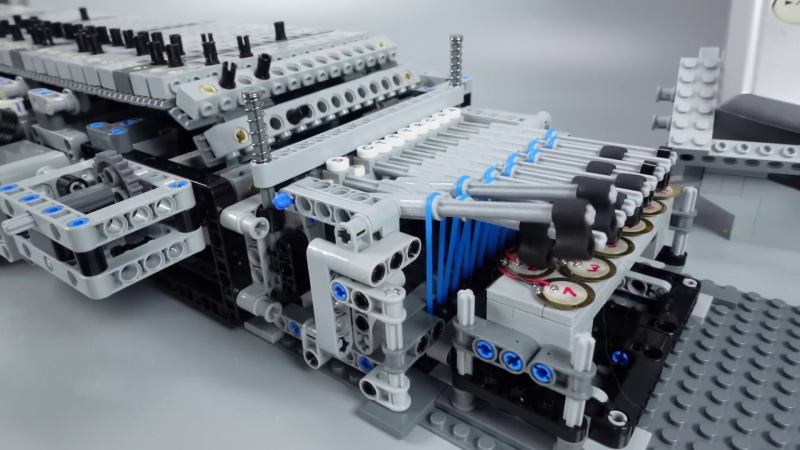The ability to quickly try out an idea, and then expand and develop it, is what rapid prototyping is all about. Although we tend to think of 3D printing when rapid prototyping is mentioned, [Brick Technology] reminds us of the power of Lego, as he rapidly builds and improves an electromechanical drum machine.
Using Lego Technic pieces, he starts with a simple music box-style drum with moveable pins that pluck on spring-loaded levers, which in turn hit piezoelectric discs. The electronics side is simple, with the discs wired to a Roland sound module from an existing electronic drum kit. With the ability to instantly adjust, add and remove pieces, he quickly finds and fixes the problem of getting eleven hammer mechanisms together and working smoothly.
To get around the limited pin space on the drum and increase the length and variation potential of the rhythms, [Brick Technology] moved to a belt design that can accommodate significantly more pins. He also added an electric motor and various gearbox ratios for consistent and adjustable tempo. Together with his water vortex ball machine, he makes us think our workshops probably need a few hundred Lego Technic pieces.
To add to the list of excuses to get more Lego, we’ve also seen the plastic blocks get used for everything from RC submarines to reaction wheels and even data storage.
















Absolutely Brilliant!
“Using Lego Technic pieces”
LEGO, always capitalized, never pluralized.
What are you, a lego lawyer? :)
Check wikipedia. And it’s not “Legos” either, though that’s not here.
A lot of people are a little too protective of the Lego corporation. It inevitably comes up in every thread about them.
I agree, legos are pretty great.
How does one amass so many great LEGO technic parts. Why don’t they sell like an experimental kit or something?
You may be interested in the LEGO Educational sets. For instance the #45400 BricQ Motion Prime Set, #9607-1 Technology Activity Set, or the older MindStorms Educational set, to name some.
Also the LEGO Chain Reactions STEM kit by Klutz. I have this one and the earlier MindStorms EV3 Educational kit, both were fun but I was loathe to disperse the Educational Kit parts with my other Technic parts.
I love LEGO and I love this kind of kinetic project. Well done.
Not a criticism… but an honest question: Judging by what even small kits of plain LEGO blocks cost, what does it cost to build complicated mechanisms like this one?
How affordable is experimentation like this? Or…Is this simply a case where sufficient Youtube views can fund thousands of dollars worth of LEGO?
Start by buying used from bricklink.
This. Exactly this. As an AFOL myself (GBC builds) Bricklink is the place to go. I’m also a member of a LEGO club that does bulk purchases, an am fortunate to have a LEGO reseller in my city (run by club members).
So there are ways to build your LEGO collection without having to resort to buying kits at premium prices.
Well, for a while it was an average of 10 cents per piece, but, inflation means that’s probably gone up (also, the larger pieces cost a lot more than the small ones like single dots). I’d expect most of their cost on this build was the huge chain for the song data, if you did just the round circle one, it might be less than $40 (excluding the electronics).
People used to start with Lego as kids, often a gift. So buy adulthood, they have quite the collection.
People that say “Lego’s” will be immediately ejected from the LEGO club.
Nice